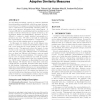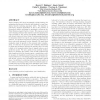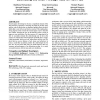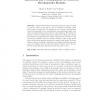82 search results - page 16 / 17 » Learning a ranking from pairwise preferences |
KDD
2007
ACM
14 years 8 months ago
2007
ACM
It is becoming increasingly common to construct databases from information automatically culled from many heterogeneous sources. For example, a research publication database can b...
KDD
2010
ACM
13 years 9 months ago
2010
ACM
Active learning (AL) is an increasingly popular strategy for mitigating the amount of labeled data required to train classifiers, thereby reducing annotator effort. We describe ...
WWW
2007
ACM
14 years 8 months ago
2007
ACM
Search engine advertising has become a significant element of the Web browsing experience. Choosing the right ads for the query and the order in which they are displayed greatly a...
UM
2010
Springer
13 years 11 months ago
2010
Springer
A user’s informational need and preferences can be modeled by criteria, which in turn can be used to prioritize candidate results and produce a ranked list. We examine the use of...
ISPW
2008
IEEE
14 years 2 months ago
2008
IEEE
Most process models calibrate their internal settings using historical data. Collecting this data is expensive, tedious, and often an incomplete process. Is it possible to make acc...




